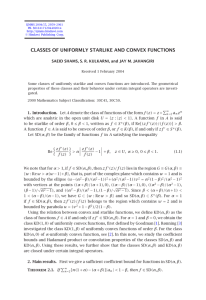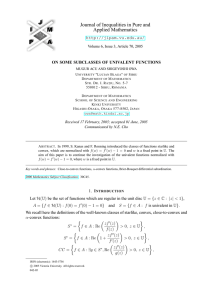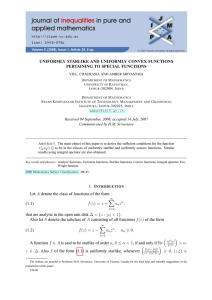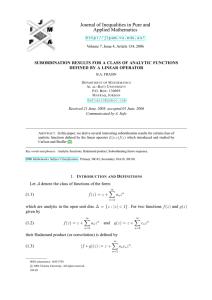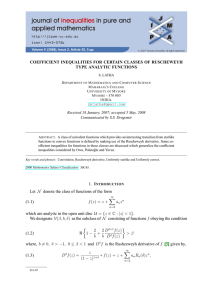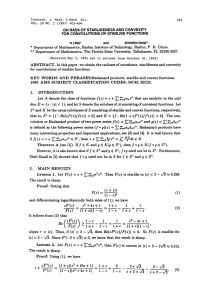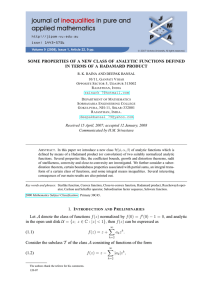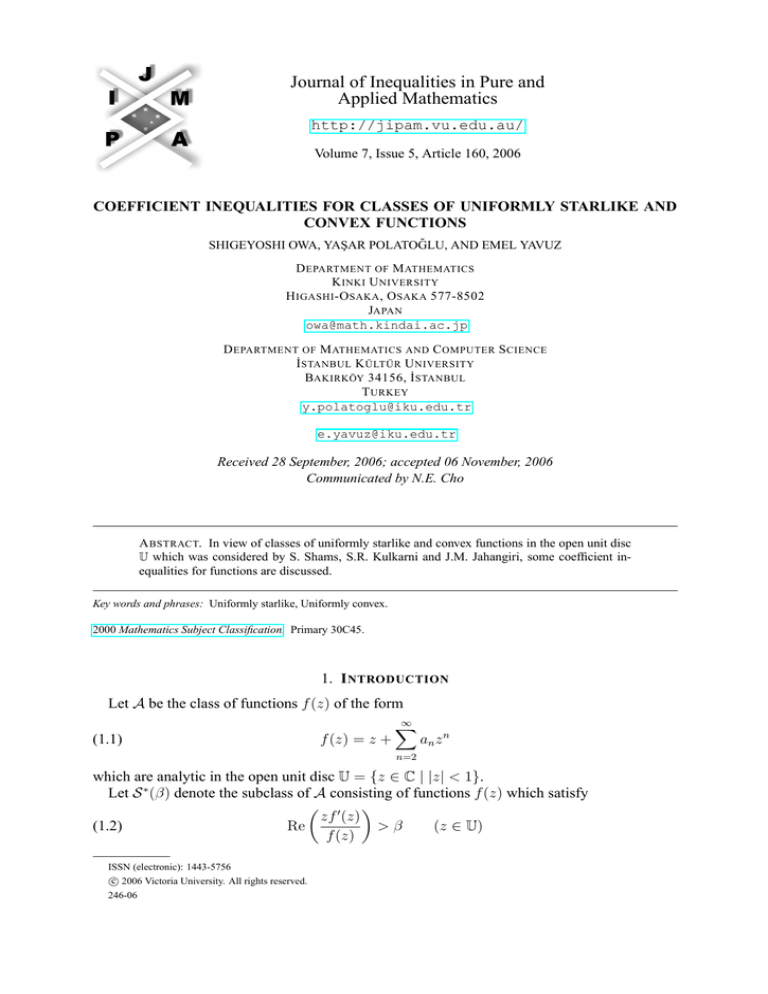
Journal of Inequalities in Pure and
Applied Mathematics
http://jipam.vu.edu.au/
Volume 7, Issue 5, Article 160, 2006
COEFFICIENT INEQUALITIES FOR CLASSES OF UNIFORMLY STARLIKE AND
CONVEX FUNCTIONS
SHIGEYOSHI OWA, YAŞAR POLATOĞLU, AND EMEL YAVUZ
D EPARTMENT OF M ATHEMATICS
K INKI U NIVERSITY
H IGASHI -O SAKA , O SAKA 577-8502
JAPAN
owa@math.kindai.ac.jp
D EPARTMENT OF M ATHEMATICS AND C OMPUTER S CIENCE
İ STANBUL K ÜLTÜR U NIVERSITY
BAKIRKÖY 34156, İ STANBUL
T URKEY
y.polatoglu@iku.edu.tr
e.yavuz@iku.edu.tr
Received 28 September, 2006; accepted 06 November, 2006
Communicated by N.E. Cho
A BSTRACT. In view of classes of uniformly starlike and convex functions in the open unit disc
U which was considered by S. Shams, S.R. Kulkarni and J.M. Jahangiri, some coefficient inequalities for functions are discussed.
Key words and phrases: Uniformly starlike, Uniformly convex.
2000 Mathematics Subject Classification. Primary 30C45.
1. I NTRODUCTION
Let A be the class of functions f (z) of the form
(1.1)
f (z) = z +
∞
X
an z n
n=2
which are analytic in the open unit disc U = {z ∈ C | |z| < 1}.
Let S ∗ (β) denote the subclass of A consisting of functions f (z) which satisfy
0 zf (z)
(1.2)
Re
>β
(z ∈ U)
f (z)
ISSN (electronic): 1443-5756
c 2006 Victoria University. All rights reserved.
246-06
2
S HIGEYOSHI OWA , YA ŞAR P OLATO ĞLU , AND E MEL YAVUZ
for some β (0 5 β < 1). A function f (z) ∈ S ∗ (β) is said to be starlike of order β in U. Also
let K(β) be the subclass of A consisting of all functions f (z) which satisfy
zf 00 (z)
(1.3)
Re 1 + 0
>β
(z ∈ U)
f (z)
for some β (0 5 β < 1). A function f (z) in K(β) is said to be convex of order β in U. In view
of the class S ∗ (β), Shams, Kulkarni and Jahangiri [3] have introduced the subclass SD(α, β)
of A consisting of functions f (z) satisfying
0
0 zf (z)
zf (z)
> α
− 1 + β
(z ∈ U)
(1.4)
Re
f (z)
f (z)
for some α = 0 and β (0 5 β < 1). We also denote by KD(α, β) the subclass of A consisting
of all functions f (z) which satisfy
00 zf (z) zf 00 (z)
+β
(1.5)
Re 1 + 0
> α 0
(z ∈ U)
f (z)
f (z) for some α = 0 and β (0 5 β < 1). Then we note that f (z) ∈ KD(α, β) if and only if
zf 0 (z) ∈ SD(α, β). For such classes SD(α, β) and KD(α, β), Shams, Kulkarni and Jahangiri
[3] have shown some sufficient conditions for f (z) to be in the classes SD(α, β) or KD(α, β).
2. C OEFFICIENT I NEQUALITIES
Our first result is contained in
Theorem 2.1. If f (z) ∈ SD(α, β) with 0 5 α 5 β or α >
1+β
2
then f (z) ∈ S ∗
β−α
1−α
.
Proof. Since Re(w) 5 |w| for any complex number w, f (z) ∈ SD(α, β) implies that
0 0
zf (z)
zf (z)
> α Re
− 1 + β,
(2.1)
Re
f (z)
f (z)
or that
Re
(2.2)
zf 0 (z)
f (z)
>
β−α
1−α
(z ∈ U).
If 0 5 α 5 β, then we have that
05
and if α >
β−α
< 1,
1−α
1+β
, then we have
2
−1 <
α−β
5 0.
α−1
Corollary 2.2. If f (z) ∈ KD(α, β) with 0 5 α 5 β or α >
1+β
,
2
then f (z) ∈ K
β−α
1−α
.
Next we derive
Theorem 2.3. If f (z) ∈ SD(α, β), then
(2.3)
J. Inequal. Pure and Appl. Math., 7(5) Art. 160, 2006
|a2 | 5
2(1 − β)
|1 − α|
http://jipam.vu.edu.au/
U NIFORMLY S TARLIKE AND C ONVEX F UNCTIONS
3
and
(2.4)
n−2
Y
2(1 − β)
2(1 − β)
|an | 5
1+
(n − 1) |1 − α| j=1
j |1 − α|
Proof. Note that, for f (z) ∈ SD(α, β),
0 β−α
zf (z)
Re
>
f (z)
1−α
(n = 3).
(z ∈ U).
If we define the function p(z) by
0
p(z) =
(2.5)
(z)
(1 − α) zff (z)
− (β − α)
1−β
(z ∈ U),
then p(z) is analytic in U with p(0) = 1 and Re(p(z)) > 0 (z ∈ U). Letting p(z) = 1 + p1 z +
p2 z 2 + · · · , we have
!
∞
1−β X
n
0
pn z .
(2.6)
zf (z) = f (z) 1 +
1 − α n=1
Therefore, (2.6) implies that
(2.7)
(n − 1)an =
1−β
(pn−1 + a2 pn−2 + · · · + an−1 p1 ).
1−α
Applying the coefficient estimates such that |pn | 5 2 (n = 1) (see [1]) for Carathéodory functions, we obtain that
(2.8)
|an | 5
2(1 − β)
(1 + |a2 | + |a3 | + · · · + |an−1 |).
(n − 1) |1 − α|
Therefore, for n = 2,
|a2 | 5
2(1 − β)
,
|1 − α|
which proves (2.3), and, for n = 3,
2(1 − β)
|a3 | 5
2 |1 − α|
2(1 − β)
1+
|1 − α|
.
Thus, (2.4) holds true for n = 3.
Supposing that (2.4) is true for n = 3, 4, 5, . . . , k, we see that
2(1 − β)
2(1 − β) 2(1 − β)
2(1 − β)
|ak+1 | 5
1+
+
1+
k |1 − α|
|1 − α|
2 |1 − α|
|1 − α|
)
k−2
Y
2(1 − β)
2(1 − β)
+ ··· +
1+
(k − 1) |1 − α| j=1
j |1 − α|
k−1 2(1 − β) Y
2(1 − β)
=
1+
.
k|1 − α| j=1
j|1 − α|
Consequently, using mathematical induction, we have proved that (2.4) holds true for any n =
3.
J. Inequal. Pure and Appl. Math., 7(5) Art. 160, 2006
http://jipam.vu.edu.au/
4
S HIGEYOSHI OWA , YA ŞAR P OLATO ĞLU , AND E MEL YAVUZ
Remark 2.4. If we take α = 0 in Theorem 2.3, then we have
Qn
j=2 (j − 2β)
|an | 5
(n = 2)
(n − 1)!
which was given by Robertson [2].
Since f (z) ∈ KD(α, β) if and only if zf 0 (z) ∈ SD(α, β), we have
Corollary 2.5. If f (z) ∈ KD(α, β), then
|a2 | 5
(2.9)
1−β
|1 − α|
and
n−2
Y
2(1 − β)
2(1 − β)
|an | 5
1+
n(n − 1) |1 − α| j=1
j |1 − α|
(2.10)
(n = 3).
Remark 2.6. Letting α = 0 in Corollary 2.5, we see that
Qn
j=2 (j − 2β)
|an | 5
(n = 2),
n!
given by Robertson [2].
Further applying Theorem 2.3 we derive:
Theorem 2.7. If f (z) ∈ SD(α, β), then
(
)
!
2(1 − β)
1+
|z|n
j|1
−
α|
j=1
!
∞
n−2
Y
2(1 − β) 2 X 2(1 − β)
2(1 − β)
5 |f (z)| 5 |z| +
|z| +
1+
|z|n
|1 − α|
(n
−
1)|1
−
α|
j|1
−
α|
n=3
j=1
∞
2(1 − β) 2 X 2(1 − β)
max 0, |z| −
|z| −
|1 − α|
(n − 1)|1 − α|
n=3
n−2
Y
and
∞
X
4(1 − β)
2n(1 − β)
max 0, 1 −
|z| −
|1 − α|
(n − 1)|1 − α|
n=3
(
)
!
2(1 − β)
n−1
1+
|z|
j|1 − α|
j=1
!
∞
n−2
X
Y
4(1
−
β)
2n(1
−
β)
2(1
−
β)
5 |f 0 (z)| 5 1 +
|z| +
1+
|z|n−1 .
|1 − α|
(n
−
1)|1
−
α|
j|1
−
α|
n=3
j=1
n−2
Y
Corollary 2.8. If f (z) ∈ KD(α, β), then
(
)
!
2(1 − β)
1+
|z|n
j|1
−
α|
j=1
!
∞
n−2
X
Y
1−β 2
2(1 − β)
2(1 − β)
5 |f (z)| 5 |z| +
|z| +
1+
|z|n
|1 − α|
n(n − 1)|1 − α| j=1
j|1 − α|
n=3
∞
1−β 2 X
2(1 − β)
max 0, |z| −
|z| −
|1 − α|
n(n − 1)|1 − α|
n=3
J. Inequal. Pure and Appl. Math., 7(5) Art. 160, 2006
n−2
Y
http://jipam.vu.edu.au/
U NIFORMLY S TARLIKE AND C ONVEX F UNCTIONS
5
and
(
)
!
2(1 − β)
1+
|z|n−1
j|1
−
α|
j=1
!
∞
n−1
X
Y
2(1
−
β)
2(1
−
β)
2(1
−
β)
5 |f 0 (z)| 5 1 +
|z| +
1+
|z|n−1 .
|1 − α|
(n
−
1)|1
−
α|
j|1
−
α|
n=3
j=1
∞
X
2(1 − β)
2(1 − β)
max 0, 1 −
|z| −
|1 − α|
(n − 1)|1 − α|
n=3
n−1
Y
R EFERENCES
[1] C. CARATHÉODORY, Über den variabilitätsbereich der Fourier’schen konstanten von possitiven
harmonischen funktionen, Rend. Circ. Palermo, 32 (1911), 193–217.
[2] M.S. ROBERTSON, On the theory of univalent functions, Ann. Math., 37 (1936), 374–408.
[3] S. SHAMS, S.R. KULKARNI AND J.M. JAHANGIRI, Classes of uniformly starlike and convex
functions, Internat. J. Math. Math. Sci., 55 (2004), 2959–2961.
J. Inequal. Pure and Appl. Math., 7(5) Art. 160, 2006
http://jipam.vu.edu.au/

